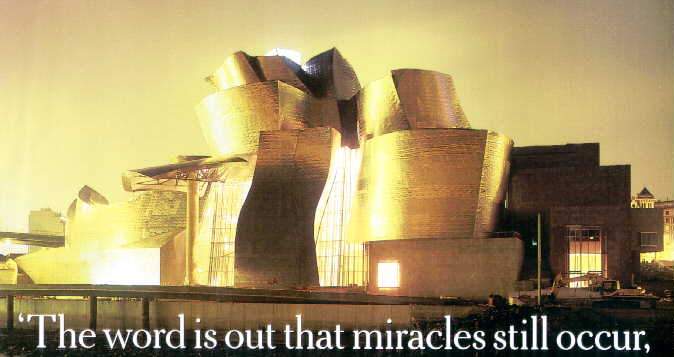
6 September 1997
Source: Hardcopy of The New York Times
Magazine, September 7, 1997, pp. 54-59, 72, 82

By Herbert Muschamp
Herbert Muschamp is the architecture critic for The Times.
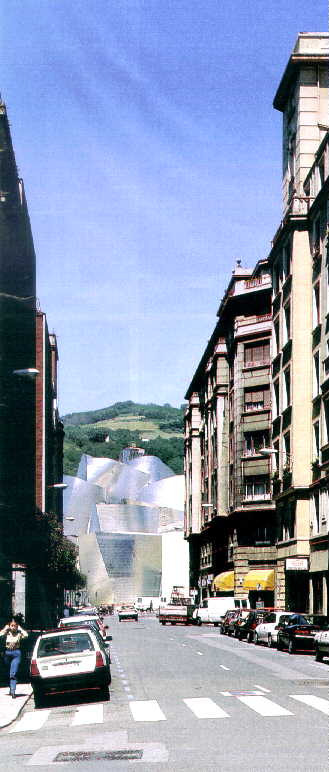
Democratic vista: The 19th-century city is the wellspring of Gehry's architecture, and it is crucial to him that his museum be a shining part of the babble and hubbub of urban life.
IF YOU WANT TO LOOK INTO THE HEART OF AMERICAN ART today, you are going to need a passport. You will have to pack your bags, leave the U.S.A. and find your way to Bilbao, a small, rusty city in the northeast corner of Spain. The trip is not convenient, and you should not expect to have much fun while you're there. This is Basque country. A region proudly, if not officially, independent from the rest of Spain, it is also bleakly free from Spanish sophistication. Oh, and by the way, you might get blown up. Basque country is not Bosnia. But it's not Disney World, either. History here has not been sanitized into a colorful spectacle for your viewing enjoyment. People are actually living history here, punctuated by periodic violence. Those who visit Bilbao, however, may come away thinking that art is not entirely remote from matters of life and death.
Bilbao has lately become a pilgrimage town. The word is out that miracles still occur, and that a major one has happened here. The city's new Guggenheim Museum, a satellite of the Solomon R. Guggenheim Foundation in New York, opens on Oct. 19. But people have been flocking to Bilbao for nearly two years, just to watch the building's skeleton take shape. "Have you been to Bilbao?" In architectural circles, that question has acquired the status of a shibboleth. Have you seen the light? Have you seen the future? Does it work? Does it play?
Designed by Frank Gehry, the Bilbao Guggenheim is the most important building yet completed by the California architect. The miracle taking place here, however, is not Gehry's building, wondrous as it is. The miraculous occurrence is the extravagant optimism that enters into the outlook of those who have made the pilgrimage. What if American art has not, after all, played itself out to its last entropic wheeze? What if standards of cultural achievement have not irretrievably dissolved in the vast, tepid bath of relativity, telemarketing and manipulated public opinion? Has it even become possible, once again, to think about beauty as a form of truth?
Ring-a-ding-ding.
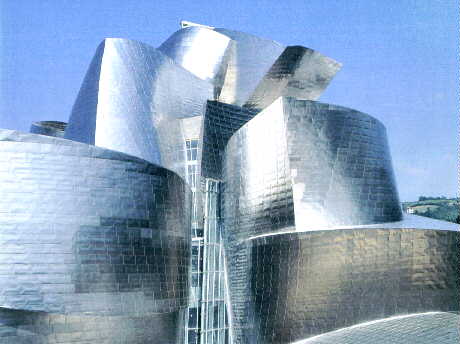
Museum pieces: A titanium explosion;
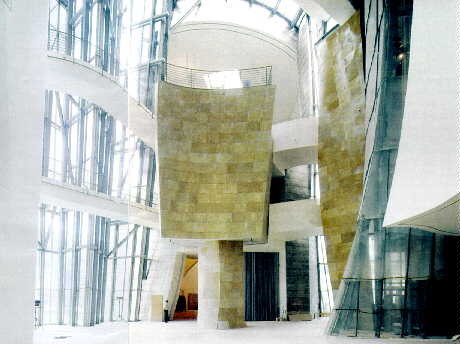
the spatial surprise of the atrium;
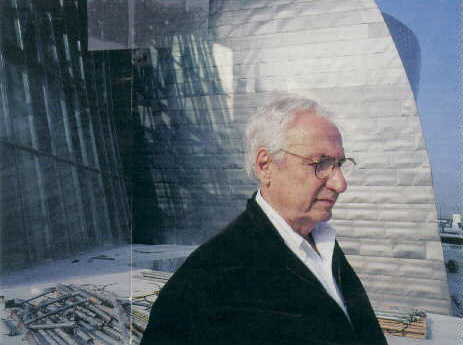
at street level, with the architect;
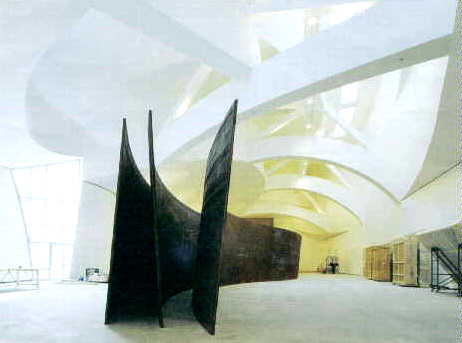
Richard Serra's curves at play with Gehry's.
[Five small images omitted] A private language goes public: Gehry's Santa Monica house, top right, a tour de force of plywood, cinder block and other crude industrial materials; a Gehry office building in Prague, center, and a Gehry-designed lamp with his signature fish, bottom. Opposite page: Gehry's workshop in santa Monica.
FRANK GEHRY, WHO IS 68, HAS BEEN AN IMPORTANT FIGURE IN architecture since 1978, the year he completed the remodeling of his home in Santa Monica, Calif An extensively overhauled version of a generic Dutch-roofed suburban house, the building employed an original vocabulary of crude industrial materials: chain-link fence, plywood, galvanized zinc, cinder block, exposed wood framing. These he arranged into a composition of lopsided cubes, exposed-stud walls and other unruly shapes. In the past five years, Gehry has completed such major buildings as the University of Toledo Center for the Visual Arts, the Frederick R. Weisman Museum in Minneapolis, the American Center in Paris, an office building in Prague. These projects not only represent an enlargement in architectural scale. They have also extended what seemed a purely private, idiosyncratic language into the larger dimension of public meaning.
Gehry's own house was a tour de force, but it was, after all, an architect's home. And a California architect's home, at that. Even 10 years ago, it wasn't uncommon to hear him described as "an artist"--a maker of sculptures rather than buildings--or "Looney Tunes." People still say such things, in fact. Yet the scale of the new buildings and their high-profile reception in the news media suggest that the architectural climate has changed. People now recognize not only that Gehry is an architect--one who can bring a major project like the Guggenheim in on time and budget--but that his work is able to arouse a broad range of meanings, associations and projections, not least in those who actively dislike it. The idea has gained wider acceptance that art and Looney-Tuneville actually speak to broad contemporary social and cultural norms. The real fruitcakes today may be those who persist in denying this.
QUESTION FOR A SUNDAY AFTERNOON: WHAT IS A MASTERPIECE? (a) Gio Ponti said that the architect's task is to interpret a community to itself (b) Iris Murdoch wrote, "Serious art is a continuous working of meaning in the light of the discovery of some truth." (c) Diana Vreeland once described Vogue magazine as "the myth of the next reality." (d) All of the above. Answer: (d) All of the above. Add up these ideas, and you won't be far from a working definition of the ideal America's greatest architects have long aspired to.
Another question: What is a community at the end of the 20th century? A focus group, a concentration camp, a chat room on the Internet, an address book, a dance club, all those afflicted with a particular incurable disease, a gender, an age bracket, a waiting room, owners of silver BMW's, organized crime, everyone who swears by a particular brand of painkiller and a two-block stretch of Manhattan on any weekday at lunch hour.
Social fragmentation is one of the truths Frank Gehry has sought to explore in his work, not because he loves to see things fall apart but, on the contrary, because he seeks meaning in a culture that would otherwise dissolve all intelligence in a deluge of demographics. Truth No. 2: These differences are superficial. People need love and they need work. These are the places meaning comes from. Everything else is superfluous. Truth No. 3: Superfluous things are a hoot and a holler. Superficiality can be wonderful. The Myth of the Next Reality, a.k.a. Utopia, is that there is a place where differences and commonalities, unity and diversity, can be seen as the poles around which beauty revolves. The axis between these poles is called empathy.
That most divine of all human qualities--empathy--is the source of meaning in Frank Gehry's designs. His aim is not to found a school, not to create a style. Rather, he is possessed by the gaga 19th-century notion that by exercising their imaginations artists can inspire others to use their own.
FROM THE AIRPORT, YOU APPROACH BILBAO THROUGH A HILLY LANDscape that grows gradually more civilized with the brutal mess of urban industry. The road cuts through a valley: Bilbao and its river, the Nervion, suddenly appear, spread out like a dreamscape, far beneath what you took to be a low point of the land. Gehry's building, too, flashes briefly into view, its curving walls of titanium steel glinting an unmistakable welcome. Then the taxi plunges into the city and the river disappears, the museum vanishes and you are swallowed up by the streets of an unremarkable town.
This entrance should be considered part of Gehry's design. Consider, by contrast, the approach to the Metropolitan Museum in New York, where the ceremonial way is paved via Fifth Avenue, a block-long Beaux-Arts facade, a grand staircase. In Bilbao, the procession includes slag heaps, a decayed industrial riverfront, bridges, highway overpasses. The scene is neither sylvan nor classically urbane. But it strongly projects an image of the industrial power that drove the 19th-century city into being. That city is the wellspring of Frank Gehry's architecture. Often, he wears the costume of a working-class hero: blue shirts, windbreakers, baggy slacks. Some have taken this for affectation. It isn't. Gehry is a man deeply ingrained with appreciation for the industrial city as the place where 18th-century theories of modern democracy were put into messy practice, the place where wits, nerve, work, education and dreaming displaced ownership of land as the basis of the good life.
Gehry was born too late to be a builder of that city. His career, rather, has corresponded to--indeed epitomizes--the transformation of the industrial metropolis into the post-industrial urban center, the place where tourism and cultural enterprise are now expected to fill the void left by the exportation of factory production to the third world. The standard remedy is: Send in the artists. Build a museum, a performing-arts center; change the zoning regulations so that industrial buildings can be converted to artists' lofts. The theory is that, in a post-industrial society, factory production will be supplanted by more creative work--that instead of blue-collar workers, the city will become home to "symbolic analysts," to use Robert Reich's phrase. In practice, production has given way to consumption: franchise outlets for cookies, ice cream, T-shirts; the invasion of the urban center by the ethos of the suburban mall. There are worse alternatives. Also better ones.
Bilbao, Spain's fourth-largest city, was once a shipbuilding town. The Bilbao Guggenheim is part of an ambitious plan to retool the city as an international center of culture and finance. Other projects, in addition to the $100 million museum, include a new subway system with stations designed by Norman Foster and a new airport designed by Santiago Calatrava. The Guggenheim, which has been expanding its international operations since the appointment of Thomas Krens as director in 1988, reached an agreement to open the Bilbao branch six years ago. Two regional governments have underwritten the costs of constructing and operating it for at least 20 years. In exchange, the Guggenheim will provide use of its collection of modern and contemporary art, curatorial expertise and prestige.
Krens, who worked closely with Gehry on the museum's design, has been frequently maligned by those who resent his global aspirations, his wheeler-dealer ways. But let the bean counters count beans, the gum chewers chew gum. As the patron of projects by Gehry, Arata Isozaki, Gae Aulenti, Zaha Hadid and Hans Hollein, Krens has given architecture stronger support than any other American museum director in the past half-century.
IN JULY, I GO TO MEET GEHRY IN BILBAO FOR A PREVIEW OF THE MUseum. "Do you want to see the building?" he asks, when we meet at my hotel. What a card. We walk along the Calle de Iparraguirre, which frames a vista of the building's central rotunda. It strikes me that that street's visual clutter--parked cars, traffic signs, lampposts--magnify rather than distract from the building's impression. The museum looks like nothing else, but nonetheless looks at home. Even the dotted line painted down the middle of the street and the stripes of the pedestrian crosswalk at the corner look somehow Gehry-fied, an accidental version of the lines Renaissance artists used with such precision in architectural drawings to highlight the new laws of visual perspective.
The rotunda, rising 138 feet above street level, is wrapped with voluptuous curves of steel clad in titanium panels. The eye takes in this vista more as a mass of gathered light than as a proper building. The darkness of the narrow street turns the metal's brightness into a retinal explosion. But the light is soft. The metal seems to absorb light as well as reflect it, like the dull side of a piece of tinfoil. The expanses of titanium, partly discolored by weathering, are changed in appearance by clouds and the location of the sun. The metal folds mount higher toward the rotunda's center, like the leaves of an artichoke with clipped tips.
A pillbox of metal and glass protrudes at a slight tilt from the top of this steel blossom. As we walk toward the building, Gehry says that he now regrets this feature: "It looks like a pimple. But I guess it's O.K. for a face to have a pimple." On closer approach, a wing of more conventional dimensions slips into a view. It is boxy, as modern buildings were once supposed to be, and contains suites of classical galleries. The wing's rectangular contour serves as a foil, so to speak, for the foil. It is clad in honey-colored limestone. Light bounces back and forth between stone and metal as if within the facets of crystal embedded in rock.
A reverse grand staircase--funnel-shaped, it descends instead of rising--pours you into the building, leading you into the great spatial surprise of the museum's atrium. Even if you entered at ground level, the atrium would be a marvel. Contained spaces can seem immensely more vast than their containers--think of Frank Lloyd Wright's Guggenheim or New York's Grand Central Terminal. But because the staircase Gehry has designed draws you down a full story below ground level, the atrium pitches you into an enclosed version of the state of surreality that overtakes you on entering Bilbao. Pinch yourself, but don't wake up. It's better just to dream this.
The atrium offers a distilled concentration of the building's material vocabulary. Stone, glass, titanium, curves, straight lines, opacity, transparency, openness and enclosure are brought into sensuous conjunction. You may think, as you stand within this space, that the Tower of Babel story was a myth concocted by people who were afraid of diversity. Here you see that many languages can not only coexist but also babble around within a broad and vibrant vista of the world.
GALLERIES STRETCH OUT FROM THE ATRIUM IN A variety of shapes and sizes. Two wings contain classically rectangular, if over-scaled, galleries that open off one another in the traditional linear enfilade. Rubens's gigantic allegorical paintings of Marie de' Medici, one of the Louvre's finest treasures, would look fabulous here. The symmetrical form of the galleries is partly masked by the exterior's metal whorls, and also by the petal shapes of the galleries clustered round them. By now, you get the point that something is being said here on behalf of irregularity. Hurtling off in a third direction, parallel to the riverfront, is the most dramatic of the galleries, a 433-foot-long tube of space: a tunnel or internal boulevard. Gehry calls it "the boat." As you proceed along it, there are shifts in scale and contour, as there might be on a city street. The ceiling, supported by giant, white trusses, drops in a swift decline from an outlandishly high 85 feet to less than half that. The walls contract; the acoustics change.
The show doesn't end here. It continues outside, where the exit to the riverfront is even more ceremonially grand than the building's entrance. A metal canopy, held aloft by a single slender column, seems to billow in the breeze 92 feet above the ground, and the entire riverfront facade looks windswept. Toward the right, a city bridge slips over a corner of the building, the roadway forking into two overpasses as it makes contact. Then, on the bridge's far side, the building flares up into a pair of steel towers, their arcs echoing, in vertical form, the fork in the road.
The towers are clad on three sides only, revealing the metal framework within. Though containing no usable spaces, they are not functionless. They enable the museum to be seen along the river and from the city's downtown. Like the Twin Towers in New York, they are symbols of themselves. And they are also emblematic of Gehry's intention to merge with urban infrastructure. In the past, Gehry has often used building skins as wrappers, surfaces that part to reveal the volume within. Here, he has used three-dimensional forms to wrap his arms around a city.
AT THE TIME OF MY VISIT, ONLY ONE ARTWORK HAD BEEN INstalled, Richard Serra's "Snake." Perhaps it is not possible to evaluate the building without considering the question of how well it functions as a showcase for art. It may be, however, that one of this building's major functions is to live that question through. Over time, people will judge how well or how badly the museum displays individual works of art. But these judgments may well be shaped by the increasing awareness that art resides only partly within individual artworks. It also lives in the spirit of risk and experimentation that works of art help sustain. This awareness is a central characteristic of the post-industrial city, as well as a theme of contemporary art. Art has spilled out of its classical containers into performance, the media, fashion and other ephemeral forms of expression. By the same token, at least since the advent of conceptual art, the task for many artists has been not only to create objects but also to escape their confining dimensions.
The Bilbao Guggenheim is an object, of course, however skillfully Gehry has intertwined the museum with the city around it. Still, inside and out, it's a spectacular embodiment of the tension between objects and the world beyond them. Within these far-from-neutral galleries, artworks will inevitably be drawn into complex relationships with the architecture and with one another. Outside, the design overflows any ordinary conception of what a museum, or any building, should resemble. Like the Basque region, this building is a place of contested borders.
GEHRY SAYS THAT like many young architects, he started out wanting to change the world. He was concerned with city planning, social justice, a more equitable environment. Yet he has managed to effect change on a scale few architects achieve.
In Los Angeles in 1983, Gehry took a service station for municipal vehicles and converted it into the Temporary Contemporary museum, a building that declared an end to the city's sense of cultural inferiority far more effectively than Arata Isozaki's permanent Museum of Contemporary Art. The Temporary's shrewd and gritty informality told Los Angelenos that an architectural intelligence of unequaled stature was one of their own.
Gehry's impact has been on consciousness, that is to say, not just particular parcels of land. And in the post-industrial city, it may no longer be possible to divorce consciousness from material reality. What was once the radical outlook of Surrealism has become part of the logic of everyday life. Ideas, images and illusions now occupy the places once held by sweaters, ball bearings and vacuum tubes.
Several weeks ago, when I was visiting Los Angeles, Gehry said, "You know, I wasn't supposed to be this." Meaning, I suppose, this big honcho. Or this big Looney Tune. I didn't press him to say how he used to think his life would turn out. I didn't want to force him to be falsely modest, or even genuinely so. But it must be scary to find people looking at you and writing about you as a person who has changed an art form and in the process is changing a culture. I imagine that sometimes Gehry must feel like the movie director Marcello Mastroianni plays in Fellini's "8 1/2," when, during the news conference scene, he tries to crawl under the table to get away as one of the reporters cackles with glee: "He has nothing to say! Nothing to say!"
In one sense, in fact, Gehry does have nothing to say. His language is architecture, not words. Though Gehry actually writes with beautiful clarity and his lectures have become extraordinary pieces of stand-up humor, he distrusts words. He lives on the opposite side of the world from architects like Peter Eisenman who feel that they cannot proceed safely into the world unless armored with academic jargon.
The first time I visited Gehry's Santa Monica office, I had to fight off a feeling of awkwardness, because he was so taciturn. Basically, he just guided me around, pausing here and there to point out and just barely identify a model for a new project or a sample of materials. Since I was there to learn, I took Gehry's silence as part of the lesson. I sensed he felt that words have the power to limit, and therefore to exclude. People can make their own pictures.
Gehry sometimes does put labels on buildings, but usually these are like jokes or pet names. (In Prague, there's "Fred and Ginger.") Rarely, he will include a form that's explicitly metaphoric: in Paris, there's a series of glass panels, jutting out at different angles, that are meant to be a symbol of the openness of American culture and of France's receptivity to the United States. More typically, a figurative element will turn up transformed into an abstraction. Once I mentioned to Gehry that part of his design for the Walt Disney Concert Hall in Los Angeles reminded me of the scalloped side of a bass viol. He wasn't dismayed that the source of an abstract shape had been recognized. He said, "You know, I have been looking at that!"
FOOLS GIVE YOU REAsons. Wise men never try. An architecture critic has no choice but to be foolish on this occasion, however. If a critic wants to say that the Bilbao Guggenheim is, in effect, a Lourdes for a crippled culture, then some kind of case must be made.
The Bilbao Guggenheim is approached through time as well as space: to get there, the visitor passes through history and geography both. This building's design and construction have coincided with the waning of a period when American architecture spectacularly lost its way.
Post-modernism, "with its sad air of the parade's -gone by," in Arlene Croce's choice phrase, started out as a constructive movement. In the mid-1960's, a few architects set out to educate themselves about the history of an art form that a Bauhaus-influenced education had plowed under. Gifted architects like Robert Venturi, Aldo Rossi and Charles Moore used these ideas to free themselves from the strangulating orthodoxies of the modern movement. This period lasted for 10 years. By the mid-1980's, the movement had deteriorated into a career strategy for reactionaries, opportunists and their deeply uncultivated promoters. These people had spent, maybe, a summer vacation in Europe and somehow arrived at the belief that this experience entitled them to be spokes-models for the Great Western Tradition. Even without the help of the Disney company, architecture plummeted into the realm of the packaged tour.
Post-modernism gained architects esthetic freedom. Few made good use of it. Despite intermittent creative flashes, the movement overall resembled a shelf of Harlequin romance novels pretentiously mislabeled as literature. I think of the past 20 years as the Franziska Schankowska period of American architecture, in honor of the Polish factory worker who jumped into a Berlin canal and resurfaced moments later as the Grand Duchess Anastasia.
Like Schankowska, many post-modernists were inspired dreamers and schemers, but their movement bore no more relation to history than Schankowska did to the Romanovs. Instead, it pandered to people's fear of history, holding out the delusion that they could step out of their own life and times.
One reason people have descended on Bilbao with such hope is that with this building, American architecture has jumped back into the present with a splash. This antique art form has made it. It has come through. And so has the consensus of informed opinion that once made it possible to say, This is better than that.
lT CAN TAKE AWHILE FOR an event to work its way into consciousness. After my first visit to the building, I went back to the hotel to write notes. It was early evening and starting to rain. I took a break to look out the window and saw a woman standing alone outside a bar across the street. She was wearing a long, white dress with matching white pumps, and she carried a pearlescent handbag. Was her date late? Had she been stood up?
When I looked back a bit later, she was gone. And I asked myself, Why can't a building capture a moment like that? Then I realized that the reason I'd had that thought was that I'd just come from such a building. And that the building I'd just come from was the reincarnation of Marilyn Monroe.
There's a scene in "The Misfits" in which she goes out to Eli Wallach's unfinished house in the Nevada desert to try the house, the desert and her future on for size. "I can go in and I can come out--I can go in and I can come out," Monroe cries with delight, after some cinder blocks were put down where the front step is supposed to be. Wallach points to the unadorned balloon frame: "This was gonna be another bedroom." Monroe says wistfully, "It's even nice this way."
What twins the actress and the building in my memory is that both of them stand for an American style of freedom. That style is voluptuous, emotional, intuitive and exhibitionist. It is mobile, fluid, material, mercurial, fearless, radiant and as fragile as a newborn child. It can't resist doing a dance with all the voices that say "No." It wants to take up a lot of space. And when the impulse strikes, it likes to let its dress fly up in the air.
What was Monroe's secret for looking sexy on film? Maybe she took her acting teacher's advice and thought about Frank Sinatra and a Coke. What does Frank Gehry think about when he is coaxing these mercurial images out of his mind? He could be thinking about a fish. In interviews the architect has said that as a child his schoolmates called him "Fish." It seems that his grandmother used to prepare gefilte fish in the bathtub of the apartment where he grew up and that the scent clung to his skin. True or not, the fish has been a recurring image in Gehry's work for many years. He has designed lamps, restaurants, even bus stops in the form of fish. The panels of metal and stone applied to the surface of the Guggenheim adhere to the overlapping pattern of scales.
Gehry and Monroe never met. But for a period of time they reclined on the same couch; consulted the same analyst, anyhow. Even without knowing that, you recognize that Bilbao is a sanctuary of free association. It's a bird, it's a plane, it's Superman. It's a ship, an artichoke, the miracle of the rose. A first glimpse of the building tells you that the second glimpse is going to be different from the first. A second glimpse tells you that a third is going to be different still. If there is an order to this architecture, it is not one that can be predicted from one or two visual slices of its precisely calculated free-form geometry. But the building's spirit of freedom is hard to miss.
YOU CAN GO IN, AND YOU can come out. The interplay between in and out has been a recurring theme of architecture for the past century. The open floor plan of Frank Lloyd Wright. The primary colors and forms of Theo van Doesburg. The glass-curtain walls of Ludwig Mies van der Rohe. Twentieth-century architecture has unfolded as a series of variations on the relationship between the interior and exterior of buildings, bodies, minds--between public and private realms. Gehry extends this tradition into an era when communications technology is further shifting the boundaries between public and private space, and when an awareness of psychology has permeated and transformed the dynamics of public and private life. But his means of extending that tradition are not the same as those of the classical modernists. Instead of trying to further reduce architectural form to the bare minimum, he has gone deeper into the psychological space where images are formed and further out into the city that helps to shape them.
I realized on that first visit to Gehry's office that his designs offer few clues to the inner recesses of the architect's mind. Rather, they are an invitation for viewers to explore their own. His main preoccupation is with subtly adjusting the relationships among the forms he employs. Mine is to learn why, upon leaving his Guggenheim, a 49-year-old architecture critic might suddenly find himself speaking in the voice of Marilyn Monroe. Her presence in Bilbao is totally my projection. Gehry's delight in arousing such responses, however, is genuine.
TITANIUM IS TOUGH. BUT it's a piece of Kleenex compared with the mind of an introvert who has learned to function in extroverted ways. Isn't this the great lesson of all art museums? Even if you only think of them as excellent places to cruise, you get the basic idea. For an hour or so, you get to share the same space with a group of strangers. As you can see for yourself from the stuff on the walls, the possibilities are endless.
That is not the kind of contact that architecture ordinarily encourages. This is not a field in which introverts easily flourish. But occasionally power and imagination join hands; the Guggenheim Museum effected such a union half a century ago when it hired Frank Lloyd Wright to design its building on Fifth Avenue. It has done so once again with its new building in Bilbao.
It's not so tough for painters or sculptors to project empathy into the world. That's what the public expects from artists, after all. Ah, yes, artists, such sensitive souls, so creative and tragic. And now it's Sunday. We will go to a museum and peer into their troubled souls. And then have brunch. Bloody Mary or mimosa? But when empathy enters into architecture, a milestone has been reached. An art form that has long depended upon appeals to external authority--history, science, context, tradition, religion, philosophy or style--has at last come to the realization that nobody cares about that sort of thing anymore. Architecture has stepped off her pedestal. She's waiting for her date outside a bar on a rainy early evening in Bilbao, Spain.
THE BILBAO GUGGENheim is cause for collective pride. If one lesson can be salvaged from the painted desert in which American architecture has been stranded in recent years, it is this: When a culture lets itself settle for anything less than great, there's no telling how low it will sink. Nor is it easy to recognize the moment when the rot sets in. Architecture, no less than politics, is an art of the possible. The field has almost infinite tolerance for those who want to rob space of decency and meaning.
Here's the saving grace. We know what it's like to feel fully alive. The feeling may not happen often, but when it does, we're there. It can happen at the movies, watching baseball, while dancing, in love, at the beach, on a street, in the company of others or in perfect solitude. However long it lasts, it's an undeniable fact. It's not a theory, not a yearning for the unattainable. It's a real reason to scream. Lose composure. Throw hats into the air. It's a victory for all when any one of us finds a path into freedom, as Frank Gehry has this year in Bilbao, and beyond.
[End]